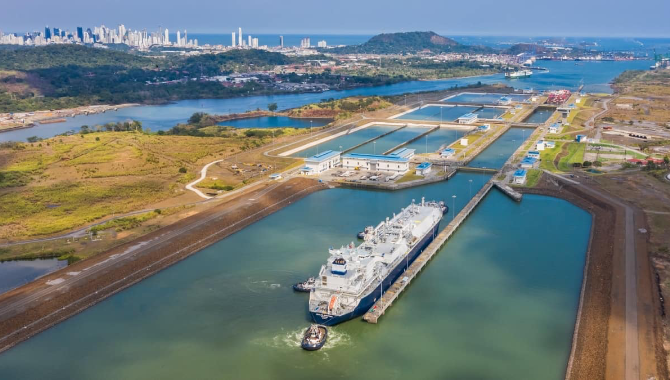[Photo: FreightWaves]
Hamburg, 30 November, 2023 — Container xChange, the leading online platform for container logistics, provides crucial insights into the far-reaching effects of the ongoing Panama Canal crisis on global trade and on the container shipping industry. With this update, we aim to assist our customers and partners with visibility into the situation for better decision making for their businesses.
Panama Canal Crisis and Global Trade Impact
The Dry Bulk and LNG segments have borne the brunt of restricted transits, particularly due to their ad hoc scheduling. In contrast, liner shipping has faced minimal consequences from transit reductions but has been significantly affected by draught reductions.
“The Dry Bulk and LNG segments have experienced the greatest impact due to restricted transits, primarily because they don't adhere to a fixed liner schedule but instead "arrive at the canal on an ad hoc basis." In contrast, liner shipping has faced minimal consequences from transit reductions but has primarily been affected by draught reductions. The maximum draught has been decreased from 50 feet to 44 feet, with each foot reduction in draught resulting in a "loss" of 400 TEU capacity. Consequently, an average container vessel can now transport 2400 TEU less.” shared Christian Roeloffs, cofounder and CEO of Container xChange.
The Panama Canal, currently spared from chaos, finds an unexpected ally in the form of a demand lull, preventing disruptions that would have posed a significant challenge for westbound trade shippers.
“At present, container shipping trade flows remain unencumbered. However, anticipating increased pressure on the US east coast, the Suez Canal and the Cape Horn in the coming months, shippers are likely to explore alternative routes to circumvent potential disruptions.” added Roeloffs.
The immediate impact includes a halved number of vessels passing through the canal, resulting in shipping companies rerouting vessels, blank sailings, longer transit times, and potential higher shipping costs in the coming times.
The mid to long term repurcussions of Panama Canal situation will run easily throughout the next year (2024) because of the irreversible environmental concerns that will dwindle the performance of the canal in time.
Current Challenges at the Panama Canal
The ongoing challenges, compounded by the Panama Canal Authority's water conservation measures in response to a drought, have led to prolonged wait times, capacity limitations, and additional strain on shipping schedules. Measures like the restriction of booking slots and adjustments to vessel weight requirements have further elongated waiting times.
The resulting supply chain disruptions are expected to reverberate throughout the industry, potentially impacting container prices. Heightened competition for available slots has driven up spot freight rates, prompting carriers to re-evaluate pricing strategies to offset increased costs and uncertainties. Several carriers have already announced new fees for Panama transits including MSC who will impose a US$297/container Panama Canal Surcharges (PCS) from 15 December.
According to the Panama Canal Authority, the average daily queue of non-booked vessels waiting for transit has increased from 2.5 days on November 4, 2023, to 9.3 days as of November 28, 2023, for northbound vessels. Southbound vessels have experienced a similar trend, reaching an average waiting time of 10.5 days.
Business Impact on US Businesses
As a response to the crisis, carriers are redirecting more volume to the U.S. West Coast or opting for routes via the Suez Canal. This shift in shipping patterns may impact transportation costs, delivery times, and overall supply chain efficiency for U.S. businesses. The potential escalation of intermodal volume to the U.S. West Coast could affect capacity and efficiency, leading to increased costs or delays for businesses relying on these services.
Outlook on the Future of US Container Logistics
The Panama Canal drought poses profound implications for global container logistics. With 40% of all U.S. container traffic transiting through the canal annually, amounting to approximately $270 billion in cargo, logistics providers may explore alternative shipping routes to alleviate potential disruptions.
To navigate potential canal-related disruptions, logistics operators may intensify their utilization of intermodal transportation and engage in renegotiating shipping contracts for the upcoming contract season in 2024. Collaborative efforts among logistics stakeholders become crucial to address the multifaceted effects of the Panama Canal congestion on global trade routes and container prices.
The opinions expressed herein are the author's and not necessarily those of The Xinde Marine News.
Please Contact Us at:
media@xindemarine.com


 Baltic Exchange launches new Fuel Equivalence Conve
Baltic Exchange launches new Fuel Equivalence Conve  21 Consecutive Years of QUALSHIP 21 Recognition for
21 Consecutive Years of QUALSHIP 21 Recognition for  MPA and Wärtsilä Renew Partnership to Drive Marit
MPA and Wärtsilä Renew Partnership to Drive Marit  MPA and Dalian Maritime University Renew Partnershi
MPA and Dalian Maritime University Renew Partnershi  PSA INTERNATIONAL, DNV AND PACIFIC INTERNATIONAL LI
PSA INTERNATIONAL, DNV AND PACIFIC INTERNATIONAL LI  INTERCARGO Reaffirms Call for Simplicity as IMO Cli
INTERCARGO Reaffirms Call for Simplicity as IMO Cli